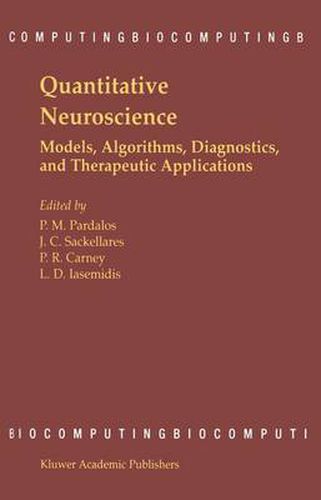Readings Newsletter
Become a Readings Member to make your shopping experience even easier.
Sign in or sign up for free!
You’re not far away from qualifying for FREE standard shipping within Australia
You’ve qualified for FREE standard shipping within Australia
The cart is loading…






This title is printed to order. This book may have been self-published. If so, we cannot guarantee the quality of the content. In the main most books will have gone through the editing process however some may not. We therefore suggest that you be aware of this before ordering this book. If in doubt check either the author or publisher’s details as we are unable to accept any returns unless they are faulty. Please contact us if you have any questions.
Advances in the field of signal processing, nonlinear dynamics, statistics, and optimization theory, combined with marked improvement in instrumenta tion and development of computers systems, have made it possible to apply the power of mathematics to the task of understanding the human brain. This verita ble revolution already has resulted in widespread availability of high resolution neuroimaging devices in clinical as well as research settings. Breakthroughs in functional imaging are not far behind. Mathematical tech niques developed for the study of complex nonlinear systems and chaos already are being used to explore the complex nonlinear dynamics of human brain phys iology. Global optimization is being applied to data mining expeditions in an effort to find knowledge in the vast amount of information being generated by neuroimaging and neurophysiological investigations. These breakthroughs in the ability to obtain, store and analyze large datasets offer, for the first time, exciting opportunities to explore the mechanisms underlying normal brain func tion as well as the affects of diseases such as epilepsy, sleep disorders, movement disorders, and cognitive disorders that affect millions of people every year. Ap plication of these powerful tools to the study of the human brain requires, by necessity, collaboration among scientists, engineers, neurobiologists and clini cians. Each discipline brings to the table unique knowledge, unique approaches to problem solving, and a unique language.
$9.00 standard shipping within Australia
FREE standard shipping within Australia for orders over $100.00
Express & International shipping calculated at checkout
This title is printed to order. This book may have been self-published. If so, we cannot guarantee the quality of the content. In the main most books will have gone through the editing process however some may not. We therefore suggest that you be aware of this before ordering this book. If in doubt check either the author or publisher’s details as we are unable to accept any returns unless they are faulty. Please contact us if you have any questions.
Advances in the field of signal processing, nonlinear dynamics, statistics, and optimization theory, combined with marked improvement in instrumenta tion and development of computers systems, have made it possible to apply the power of mathematics to the task of understanding the human brain. This verita ble revolution already has resulted in widespread availability of high resolution neuroimaging devices in clinical as well as research settings. Breakthroughs in functional imaging are not far behind. Mathematical tech niques developed for the study of complex nonlinear systems and chaos already are being used to explore the complex nonlinear dynamics of human brain phys iology. Global optimization is being applied to data mining expeditions in an effort to find knowledge in the vast amount of information being generated by neuroimaging and neurophysiological investigations. These breakthroughs in the ability to obtain, store and analyze large datasets offer, for the first time, exciting opportunities to explore the mechanisms underlying normal brain func tion as well as the affects of diseases such as epilepsy, sleep disorders, movement disorders, and cognitive disorders that affect millions of people every year. Ap plication of these powerful tools to the study of the human brain requires, by necessity, collaboration among scientists, engineers, neurobiologists and clini cians. Each discipline brings to the table unique knowledge, unique approaches to problem solving, and a unique language.